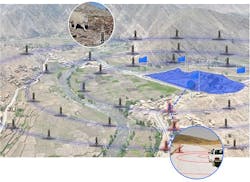DARPA N-ZERO program seeks to reduce or eliminate need for standby power on unattended sensors
ARLINGTON, Va., 9 Feb. 2015. U.S. government researchers are asking industry to find ways of boosting the energy efficiency of unattended sensors by reducing or eliminating the standby power that these sensors consume while waiting for signatures of interest.
Officials of the U.S. Defense Advanced Research Projects Agency (DARPA) in Arlington, Va., have released a solicitation (DARPA-BAA-15-14) for the Near Zero Power RF and Sensor Operations (N-ZERO) program to transform the energy efficiency of unattended sensors by eliminating their need for standby power.
The improved energy efficiency is expected to result in an increase in the sensor mission lifetime from months to years by creating intelligent sensors that can process and detect RF and physical sensor signatures, consume less than 10 nanowatts of power, and attain a low false alarm rate of 1 per hour or better in an urban environment.
The potential $30 million program should involve several contractors in an effort to design persistent-surveillance sensors that can remain dormant with near-zero power consumption, until awoken by an external trigger or stimulus.
Today's unattended sensors use active electronics to monitor the environment for the external trigger, consuming power continuously and limiting the sensor lifetime to durations of months or less, DARPA officials say. The N-ZERO program seeks to develop the underlying technologies to monitor the environment continuously and passively, and wake-up an electronic circuit upon detection of a specific trigger signature.
Related: Northrop Grumman to provide SCORPION unattended ground sensors to U.S. Army
The goal is to enable new missions that apply unattended ground sensors (UGS) for missions such as force, infrastructure, and border protection. Often UGS are deployed to detect and communicate infrequent but time-critical events.
The N-ZERO program will focus on two areas: unattended sensors that monitor the physical environment continuously with near-zero power consumption; and radio receivers that are continuously alert for friendly radio transmissions with near zero power consumption when transmissions are not present.
The program faces two primary challenges in developing an off-but-alert sensor: how to close the sizable gap between the extremely small signal levels measured by RF and physical sensors; and discriminating signals of interest from background noise.
Companies interested should submit abstracts no later than 20 Feb. 2015 online at https://baa.darpa.mil. Email full proposals no later than 23 April 2015 to https://baa.darpa.mil.
Email questions or concerns to Troy Olsson, the DARPA N-ZERO program manager at [email protected].
More information is online at https://www.fbo.gov/spg/ODA/DARPA/CMO/DARPA-BAA-15-14/listing.html.

